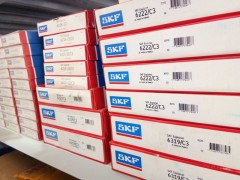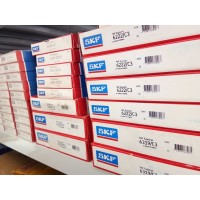在圆锥滚子徐州SKF轴承的磨削过程中,砂轮与工件的接触区消耗大量的能*量,产生大量的磨削热,导致磨削区局部瞬时高温。磨削区的瞬时温度为0.1-0.001,**大为1000-1500(?)c.利用线性移动热源传热理论*公式或红外、热电偶法推导、计算或测量实验条件下的瞬时温度。这种瞬间高温足以引起高温氧化、无定形结构、高温回火、二次淬火,甚至在工作表面一定层次的表面上烧制。
In the grinding process of SKF bearing with tapered roller in Xuzhou, a large amount of energy is consumed in the contact area between grinding wheel and workpiece, resulting in a large amount of grinding heat, resulting in local instantaneous high temperature in the grinding area. The instantaneous temperature in the grinding zone is 0.1-0.001 and ** is 1000-1500 (?) C. Derivation, calculation or measurement of instantaneous temperature under experimental conditions using linear moving heat source heat transfer theory* formula or infrared and thermocouple methods. This instantaneous high temperature is sufficient to cause high temperature oxidation, amorphous structure, high temperature tempering, secondary quenching, and even firing on a certain level of working surface.
(1)表面氧化层
(1) Surface oxide layer
在徐州SKF轴承瞬间高温的作用下,钢表面与空气中的氧气反应,形成一层很薄(20-30)的氧化铁层。值得注意的是,氧化层的厚度对应于表面磨料变质层的总厚度。结果表明,氧化层厚度与磨削过程直接相关,是衡量磨削质量的重要指标。
Under the action of instantaneous high temperature of Xuzhou SKF bearing, the steel surface reacts with oxygen in the air to form a very thin (20-30) layer of iron oxide. It is noteworthy that the thickness of the oxide layer corresponds to the total thickness of the surface abrasive metamorphic layer. The results show that the oxide layer thickness is directly related to the grinding process and is an important index to measure the grinding quality.
(2)非晶态结构层
(2) Amorphous structure layer
当工件表面在徐州SKF轴承磨削区瞬时高温下熔化时,熔化的金属分子流均匀地覆盖工作表面,以很快的速度冷凝母材,形成非常薄的非晶态结构。它有很高的硬度和韧性,但只有10左右。精*密磨削容易去除。
When the workpiece surface melts at the instantaneous high temperature in the grinding zone of Xuzhou SKF bearing, the molten metal molecule flow uniformly covers the working surface and condenses the base metal at a fast speed, forming a very thin amorphous structure. It has high hardness and toughness, but only about 10. Precision * dense grinding is easy to remove.
(3)双淬火层
(3) Double quenched layer
当磨削区的瞬时高温将工件表层加热到奥氏体化温度(1)以上时,在随后的冷凝过程中,该层的奥氏体化结构被重新淬火为马氏体。徐州SKF轴承二次淬火烧*伤的工件在二次淬火层下**须有一个硬度很低的高温回火层。
When the instantaneous high temperature in the grinding zone heats the surface layer of the workpiece above the austenitizing temperature (1), the austenitizing structure of the layer is re-quenched to martensite in the subsequent condensation process. The workpiece burned by secondary quenching of Xuzhou SKF bearing must have a high temperature tempering layer with very low hardness under the secondary quenching layer.
(4)磨削裂纹
(4) Grinding Cracks
二次淬火烧*伤可以改变工件表面层的应力。当轴承识别出轴承的真假时,通过触摸轴承上的钢印,可以更快、更准确地识别徐州SKF轴承。如果你用手触摸邮票,它就没有任何接触。但是如果你用指甲轻轻地触摸邮票,你会感到邮票被压缩了。钢印下高温回火区的材料具有**大的拉应力,**有可能发生在此处。裂缝的核心。裂纹**容易沿原始奥氏体晶界扩展。严重烧*伤会导致整个磨削表面出现裂纹(主要是裂纹),导致工件报废。
Secondary quenching burns can change the stress of the workpiece surface layer. When bearing recognizes the true or false of bearing, it can recognize Xuzhou SKF bearing more quickly and accurately by touching the steel mark on the bearing. If you touch the stamp with your hand, it has no contact. But if you touch the stamp gently with your nails, you will feel the stamp compressed. The material in high temperature tempering zone under steel stamp has ** large tensile stress, and ** may occur here. The core of the crack. Cracks ** tend to propagate along the original austenite grain boundary. Severe burns will lead to cracks (mainly cracks) on the whole grinding surface, leading to the scrap of the workpiece.
文章来自:徐州SKF轴承 www.wh-skf.com
Article from: Xuzhou SKF Bearing www.wh-skf.com
文章来自:徐州INA轴承 www.ina-china.cn
Article from: Xuzhou INA Bearing www.ina-China.cn
文章来自:徐州NSK轴承 www.klbbearings.com
Article from: Xuzhou NSK Bearing www.klbbearings.com
QQ:524085168
电话:0510-81207777
手机:13311666672/13395185757










